#the glasgow and south western
Text
Got a new book, got inspired by @mean-scarlet-deceiver doing this with the G&SWR books.
The Author thinks about L&NW exiles on the Sou' West:
"Curiously enough, it was of the L&NW that I thought in our extermity. The L&NW - hardly a railway publication could you open without accounts of the prowess of their engines - George the Fifths, Prince of Wales, Claughtons. And they had hunderds of them! Surely they could spare a few to run our trains more efficiently. I pictured a Claughton on the Pullman, a George the Fifth on the 5.10p. Glasgow to Ayr, a Prince of Wales on the Stranraer Road. A wilder flight of fancy glimpsed a Claughton tearing down fron Dalnaspidal with a 2-4-0 Jumbo as pilot. I did not know, or had forgotten that such locomotives would require a somewhat severe haircut and shave before they could have gone under some of our Scottish bridges."
- Legends of the Glasgow & South Western Railway in LMS days by David L. Smith
#real true railway stuff#the glasgow and south western#I dare not think how much they would need to trim off on a Claughton!#You think he (the author) was just hoping for anything not from the Caledonian?#Oh David#you sweet little Sou' Westerner#David l. smith#Scottish Railways
14 notes
·
View notes
Text
For, you understand, the Caley was beyond the pale. The North British were a queer folk, an outlandish folk, but our allies, and we tolerated them; but the Caley, oh Heavens, no! ... We hear the old fighting ring in the last verse and line of the famous poem that The Cuckoo made when he fired to Joe Dinwiddie at Dumfries on 259, the Stirling 0-4-2:
🎵 'We left St. Enoch station, our time was eight-sixteen.
The electric light was shining: her beauty there was seen.
We ran our miles so speedily and reached Dumfries at time,
And we beat the Caledonian with the Two-Five-Nine!'
- Tales of the Glasgow and South Western Railway, David L. Smith
#i love when guys are normal about trains <3#real true railway stuff#singing firemen appreciation post#259's glory is secure forever...#glasgow and south western engines#scottish engines#david l. smith#i would die for The Cuckoo... whatta man...
22 notes
·
View notes
Video
LMS (ex GSWR) loco No. 14116 c1925 by Frederick McLean
Via Flickr:
An old photograph of London, Midland & Scottish Railway (LMS) engine No. 14116, with driver and fireman at an unknown station. The reverse has no information on, if you know who the photographer was please message me and I will credit them. This was a H. Smellie designed class 119 4-4-0 engine, built at the Kilmarnock Works, and new to the Glasgow and South Western Railway (GSWR) in Jun 1882 carrying number 119, changing to 119A in Jan 1910, then to 700 in Jun 1919. After grouping of the existing railway companies in 1923 into 'the big four', the GSWR became part of the LMS, in 1924 they renumbered it 14116. The locomotive was withdrawn from service in Dec 1931, then I assume was scrapped, although I could not find the date/place. If there are any errors in the above description please let me know. Thanks. 📷 Any photograph I post on Flickr is an original in my possession, nothing is ever copied/downloaded from another location. 📷 -------------------------------------------------
#old photograph#old transport#vintage transport#vintage photograph#G&SWR#Glasgow and South Western Railway#LMS#London#Midland and Scottish Railway#Midland & Scottish#Midland & Scottish Railway#steam engine#steam train#steam locomotive#steam loco#old steam engine#locomotive#loco#old locomotive#railway#railway station#old railway#old railway station#H Smellie#Kilmarnock Works#4-4-0#class 119#flickr
0 notes
Text
Happy Mallard Day!
Most people in my country will be celebrating tomorrow, July 4th. I’m a bit unusual for an American in that I’m always more excited for July 3rd, because a remarkable feat of engineering history happened that day in 1938 (in multiple senses of the word). Today I’m going to tell the story of a locomotive named for a duck.
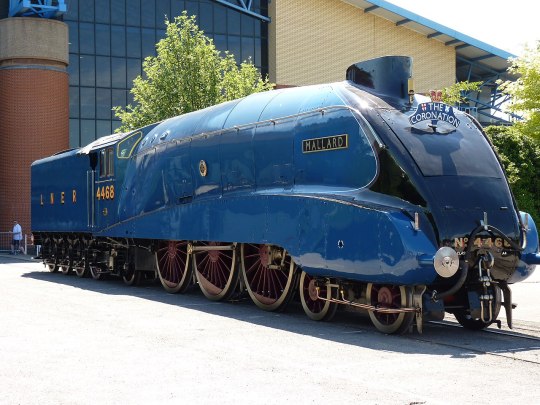
(Image: 4468 Mallard, a streamlined 4-6-2 Pacific locomotive, sitting pretty in York, England, United Kingdom. She is painted bright blue with red wheel spokes.)
The story begins well before July 3rd, 1938, of course - mechanical engineer Sir Nigel Gresley was well established in his position as the CME of the London and North Eastern Railway by that date. In 1923, his most famous creation, a 4-6-2 Pacific A1 numbered 4472, took to the rails for the first time. Originally numbered 1472, within a year of running between London to Edinburgh she received her more familiar 4472 after the LNER finally settled on a company-wide numbering scheme - and the name she’d be best known under, Flying Scotsman. She became the company’s flagship locomotive and solidified Gresley’s ability to design Pacifics in the mind of the public.
Her most important contribution to what I’m about to get into the meat of here, though, occurred on November 30th, 1934. On that date, pulling a light testing train behind her, Flying Scotsman hit 100 mph, becoming the first locomotive to hit that speed whilst being officially measured. Other locomotives may have reached 100 mph before, most notably GWR 3700 City of Truro and NYC 999, but this was the first time the speed was officially recorded, and so Scotsman got her name into the record books.
Dating back to the 19th century, railroads in Great Britain competed against each other in what was known as the Race to the North, in which they actively attempted to outdo each other and get passengers from the south, usually London, up to various destinations in Scotland. Nobody ever actually said they were racing, of course, but in retrospect it was pretty obvious what was going on as the railroads introduced faster and faster services. By the 1930s, the railroads had been consolidated into four companies - the Big Four (the Great Western, the Southern, the London, Midland and Scottish, and the heroes of this story, the London and North Eastern). The LMS controlled the West Coast Main Line, and the LNER controlled the East Coast Main Line. (This is important.) In 1927, the LNER started running the named train Flying Scotsman non-stop from London to Edinburgh, utilizing corridor tenders to perform crew changes at speed without stopping. Not to be outdone, the LMS beat them to the punch, running non-stop services between London and Glasgow and London and Edinburgh on their own, and it was officially on. Although speeds were still within a reasonable range at this point, both railroads knew they needed to go faster, and Sir Nigel Gresley looked to Germany.
In Germany, a new streamlined service called the Flying Hamburger had been introduced. This was a diesel train set that ran between Hamburg and Berlin at remarkably high speeds - it had an average speed of 77 mph and could hit around 99-100 mph at its maximum. For regular service, this was impressive, and Gresley wondered if the same could be done using steam power. He knew streamlining was the key, but the LNER knew that the diesels in Germany didn’t have the same passenger capacity as their steam locomotives could pull in carriages, so he needed to get creative. He looked to Bugatti for inspiration; their racecars, in their resplendent blue, were but one thing the car company was working on - they were making streamlined railcars, as well. Gresley took note of their designs, and his new locomotives would eventually pay homage by being colored Bugatti blue.
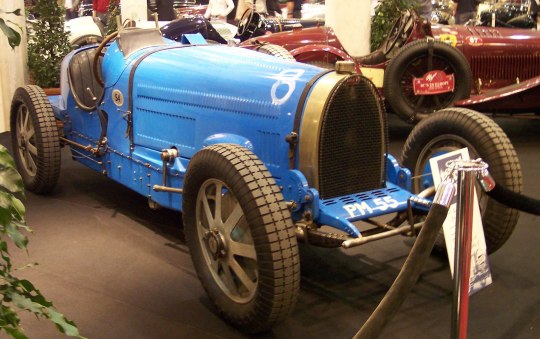
(Image: a Bugatti Type 54 racecar, painted in a vivid blue.)
By the time Flying Scotsman hit 100 mph in 1934 and another Gresley Pacific locomotive, A3 2750 Papyrus, managed to hit a whopping 108 mph without streamlining, the LNER knew that Gresley was capable of the task, and they allowed him to design a streamlined locomotive. Gresley set to work making improvements to his A3 design, and the first four A4s were born.

(Image: an unidentified A4 Pacific locomotive.)
The A4s were fast, hitting 112 mph on the inaugural run of the Silver Jubilee service between London and Newcastle in 1935. Gresley, of course, was not satisfied - he knew he could still improve his design, and at any rate, his competition over at the LMS was going to be trying to catch him. He went back to the drawing board to make the A4s even better.
As this was going on, the LMS was indeed playing catchup, and they introduced their beautiful Coronation class locomotives, designed to pull the Coronation Scot starting in 1937. The first several of them were streamlined in gorgeous, bright casings, and they caused a stir, taking the British speed record back at 114 mph in an attempt by 6220 Coronation that ended with a sudden braking and a whole lot of kitchenware being flung every which way in the dining car. Engineer/driver T.J. Clark and fireman C. Lewis kept her under control, but the passengers were not amused, and speed records were shelved for the time being...until, once again, Germany entered the fray.
Back in 1936, a German locomotive, the DRG Class 05, set a land speed record for steam, hitting 124.5 mph. Gresley was aware of this and had it in the back of his mind as he improved his A4s. He experimented with giving some of them a Kylchap exhaust system, an innovation developed by French locomotive designer André Chapelon after the work of Finnish engineer Kyösti Kylälä. Chapelon’s work went woefully under-acknowledged, but Gresley paid attention and appreciated his work, and it would pay off. Wind tunnel tests proved a bit frustrating at first until a fortuitous accidental thumbprint helped to move the smoke up and over the locomotive instead of in the crew’s faces, and the stage was set.
4468 Mallard rolled off the line at Doncaster Works on March 3rd, 1938, her name derived from Gresley’s love of breeding waterfowl. Indeed, many of her sibling locomotives were also named for birds, like 4464 Bittern, 4467 Wild Swan, 4902 Seagull, and 4903 Peregrine, but the duck was about to steal the show. Mallard spent the next few months getting used to working and being broken in so she wasn’t brand new, and on the day she turned four months old, it was time to make history.
Mallard’s driver that day was a 61-year-old grandfather named Joe Duddington. As a locomotive engineer, he was experienced and knew how to take calculated risks, and so he’d been assigned to pilot her. With him on the footplate was fireman Tommy Bray and his massive tattooed arms, ready to keep Mallard fed as they drove into the history books. They were performing a “brake test” that day, or so the LNER told most people, passengers included, but Joe and Tommy knew what was actually going on. In the cab with them was an LNER official, Inspector Jenkins, and attached to the train behind the tender was a dynamometer car, there to record Mallard’s speed throughout her run. Since this was an alleged “brake test” the dynamometer car didn’t raise any eyebrows right away. Gresley himself unfortunately wasn’t in the best health that day and was unable to be present himself, but there were enough LNER officials on hand to see to it that everything ran smoothly. Mallard was fitted with a stink bomb of sorts of aniseed in case the big end bearing for the middle of her three cylinders overheated, as the A4s had previously had difficulty with this, and she set out heading northwards. The return trip was where everything was going to get serious.
Upon turning around to return south to King’s Cross, passengers were finally informed of what was going to happen and were given the opportunity to disembark and take another train if they were worried, especially given what had happened during the LMS record attempt a year prior. Everyone agreed to stay on board. Joe Duddington turned his hat backwards, a reference to George Formby’s character in the film No Limit, and opened the throttle.
Mallard slid back onto the main line, headed towards Grantham, where the speed-up was to begin. Unfortunately, work on the track limited her to only 15 mph at this stage, and Joe Duddington got her through the Grantham station at only 24 mph instead of the 60-70 mph she should have been at. Nevertheless, she began to build up more and more speed as she climbed up Stoke Bank, and Duddington had her at a solid 85 mph at the summit.
“Once over the top, I gave Mallard her head, and she just jumped to it like a live thing,” Duddington recounted later in an interview. Her speed rapidly increased, and she was soon hitting 110 mph, at which point he told her, “Go on, old girl, we can do better than this!” Mallard responded, and by the time she was flying through a village called Little Bytham, a blur of blue paint and pumping rods and flying ash, she had well exceeded the LMS record and was even with the German DRG Class 05. The needle in the dynamometer car tipped up higher and higher and surpassed the Class 05 by slipping up to 125 mph...then, for about a quarter of a mile, reached even higher, at 126 mph. She’d done it.
Mallard had to slow down soon after because of a junction, but Joe Duddington and Tommy Bray were sure she could have gone faster had they not had to slow for construction - they believed she was capable of 130. The big end bearing did overheat, and Mallard was detached from the train at Peterborough and brought back to Doncaster to be fixed up, but not before one of the most famous photos in railroad history was taken:
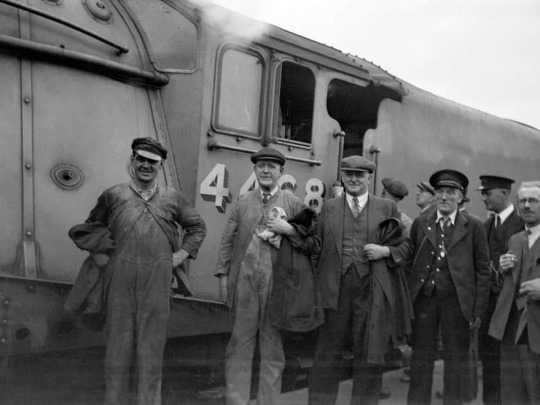
(Image: the crew poses in front of Mallard, a 4-6-2 Pacific locomotive numbered 4468, immediately after setting the speed record. L-R: Tommy Bray [fireman], Joe Duddington [driver/engineer], Inspector Jenkins, Henry Croucher [guard/conductor]. Joe Duddington has turned his hat around to face the correct way again after having it on backwards during the record run. Photo credit: National Railway Museum.)
Joe Duddington actually stayed on a bit past his retirement age to help free up soldiers for the war effort. When he finally retired, on his final day of work, he drove Mallard one last time.
Sir Nigel Gresley himself never accepted the brief stint at 126 mph, instead saying his locomotive set the speed record at 125 mph. But history has accepted the 126 mph as the true top speed, given that Mallard was possibly capable of even more, and today she has plaques on her streamlined cladding to commemorate her feat. A second record attempt was planned to see if she could go even faster, but World War II broke out and the idea was scrapped.
undefined
youtube
Tommy Bray eventually got on the throttle himself, fulfilling his own dreams. Both men are honored in a cemetery in Doncaster with a new memorial headstone for Duddington featuring Mallard on it.
As for Mallard herself, she continued working until April 25th, 1963, at which point she’d clocked nearly a million and a half miles in service. She was pulled for preservation for obvious reasons, and today she lives at the National Railway Museum in York, along with her dynamometer car that recorded her history-setting run. Five of her A4 siblings also survive, and a few of them are operational to this day, including the one named for her designer, Sir Nigel Gresley. Of all of his ‘birds,’ the one that flew fastest was the humble duck.
For more on Mallard and her creator Gresley, here are a few resources:
Mallard: How the Blue Streak Broke the World Speed Record by Don Hale is a great book on the subject that I enjoyed thoroughly. It does have a Kindle edition if you’d prefer an ebook variation, as well, and most major book retailers carry it on their websites.
The National Railway Museum, Mallard’s retirement home, has a 3D experience/ride of sorts that simulates what it was like to be running with her that day, the video of which is online here. Note the music, which mirrors her three cylinders pumping away. The video isn’t able to be embedded, but you can watch it here. There’s also a child-friendly version, too.
Lastly, the appropriately named prog rock band Big Big Train did a song about Mallard called East Coast Racer, which regularly moves me to tears because this locomotive means so much to me and they tell her story so lovingly.
undefined
youtube
I actually recommend checking out the live version, too, because they show the photo of the crew at the end and every single time I start sobbing.
If you want to visit the old girl herself, she’s at the National Railway Museum in York in the UK, and they have a ton of amazing resources and incredible locomotives and rolling stock in their collection. I’d highly recommend checking them out if you can!
Happy Mallard Day, everyone. Fly far, fly fast, make history.
#LNER Mallard#LNER 4468 Mallard#LNER#LNER A4#I like trains#I spent literal hours on this whoops#but she's really important to me
110 notes
·
View notes
Text





On July 31st 1845 The Caledonian Railway Company was incorporated by the Caledonian Railway Act.
In spite of its initial promotion and capital subscription being largely English, the Caledonian Railway became the most Scottish of the pre-grouping companies: its blue locomotives reflected the Saltire, and its adoption of both the “Lion of Scotland” and the Royal Arms of Scotland as the Company Coat of Arms meant that these appeared on everything from locomotives and carriages to buildings, timetables, stationery, and hotel crockery.
The first section of the railway between Carlisle and Beattock was opened on 10 September 1847. The line was completed to Glasgow and Edinburgh on 15th February 1848 and to Greenhill / Castlecary on 7th August 1848, where it joined the Scottish Central Railway. The line to Glasgow utilised the earlier railways Glasgow, Garnkirk & Coatbridge, and the Wishaw & Coltness, which it purchased in 1846 and 1849 respectively.
Between 1849 and 1864 the company repeatedly tried to absorb the Edinburgh & Glasgow Railway Co. into the Caledonian system. If it had succeeded the Caledonian would have had a virtual monopoly of Scottish Railways. The company however acquired other lines and later the services encompassed Aberdeen, Dundee, Forfar, Perth, Stirling, Oban, Ardrossan, Peebles and a large number of other locations.
The Company also owned two very fine hotels as part of the stations at Glasgow Central and Edinburgh Princes Street. The development of the majestic hotel and golf course at Gleneagles was interrupted by WW1 and was not fully completed until after the grouping.
Caledonian was grouped with the Glasgow & South Western Railway, the Highland Railway, the London & North Western Railway, the Midland Railway and a number of smaller railways across Scotland and England to form the London, Midland & Scottish Railway Co in 1923. This company was nationalised as part of British Rail in 1948.
16 notes
·
View notes
Text
The engines as different basis (EoSR but built different) - 1
(Tender engines as tank engines, vice versa)
From No. 1 - 6 (Thomas, Edward, Emily, Henry, Gordon, James)
NWR 1 Thomas (formerly LBSCR 307, SR 2307)

Class: London, Brighton, and South Coast Railway (LBSCR) Class C3 Horsham Goods
Previous Owners: London, Brighton, and South Coast Railway; Southern Railway; British Railways (Southern Region)
Built: August 1906
Real-life Withdrawal: May 1949 (never received a BR number)
Designer: Douglas Earle Marsh
Builder: Brighton Works
Bio:
Thomas is the first tender engine purchased by the NWR, after the withdrawals of the original NWR 1 - 6 (the last one being in 1925). The NWR had believed that they wouldn't need any tender engine power until the withdrawal of NWR 1 in 1925.
NWR 2 Edward (formerly W&SR 5)

Class: Dublin, Wicklow and Wexford Railway (DW&WR) 52 class; North Western Railway (NWR) Class S-W52
Previous Owners: Wellsworth & Suddery Railway
Built: 1893
Real-life Withdrawal: n/a
Designer: William Wakefield
Builder: Sharp, Stewart and Company (Glasgow, Scotland)
Bio:
Edward was commissioned by the Wellsworth and Suddery Railway. His design was altered so that he could run on standard gauge rails. When the merger occured, he was passed down to the NWR, along with Emily, and the NWR attempted to rebuild him so he could handle the new jobs. This did not work out, resulting in Edward having poor steaming issues. He was swapped with Emily, working lighter and fewer jobs.
NWR 3 Emily (formerly GNR 1009 and W&SR 6)



Class: Great Northern Railway (GNR) Class H1 Stirling Tank; North Western Railway (NWR) Class S-S1 Stirling Tank
Basis (Inspiration): GNR Stirling Single A3, GNR G1, and B&ER 4-2-4 tank engines
Previous Owners: Great Northern Railway; Wellsworth and Suddery Railway
Built: 1882
Real-life Withdrawal: n/a
Designer: Patrick Stirling
Builder: Doncaster Works
Bio:
Emily is an experimental tank engine version of the GNR A1, A2, and A3 Stirling Singles, with a wheel config of 4-2-4T. While she did perform decently, she did not perform as they expected so she was withdrawn. The Wellsworth and Suddery Railway took interest in Emily. They purchased her from the GNR before she could be sold to a scrapyard. She worked welled on the W&SR, able to be passed down to the NWR in 1915, along with Edward. She ended up replacing Edward on the express passenger service when the latter's rebuilds proved to worsen his performance.
NWR 4 Henry




Class: North Eastern Railway (NER) Class F; North Western Railway (NWR) Class S-S5 (4-6-4T) Black Five Tank
Basis (Inspiration): NER Class D (pre-1935); LNER Class A2 (pre-1935); LMS Class 5MT Black Fives (post-1935); LMS 4MT 2-6-4T (two-cylinder) (post-1935)
Previous Owners: Unknown
Built: 1920
Real-life Withdrawal: n/a
Designer: Vincent Raven; Henry Stanier
Builder: Unknown
Bio:
Henry was built from stolen duplicates of Vincent Raven's plans of a 4-6-2T, which were derived from the NER Class D (4-4-4T). Unfortunately, these duplicate plans were the discarded designs due to uneven weights on the chassis and the use of a Schmidt boiler. He was under-powered and a hazard to operate. Sir Louis Topham Hatt I was swindled to buy Henry in 1922 when promised that Henry would be the next best thing for railways. This was when the NWR believed that they wouldn't need tender engines to run the railway.
After the Flying Kipper crash, Henry was rebuilt into a new class of his own, the LMS Class 5MT Black Five Tank.
NWR 5 Gordon
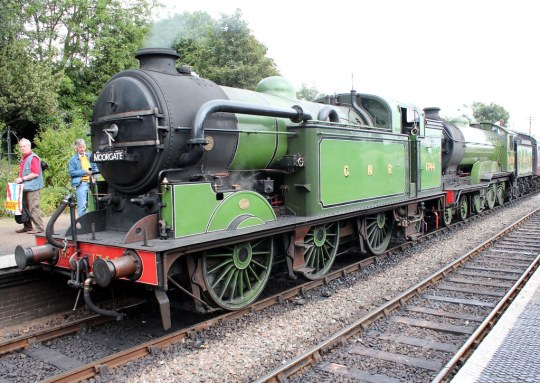
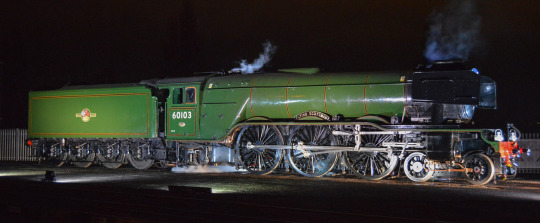
Class: Great Northern Railway (GNR) Class B1; North Western Railway (NWR) Class S-G1
Basis (Inspiration): GNR Gresley Class A1, GNR Gresley Class A3, and GNR Gresley Class N2
Previous Owners: Great Northern Railway
Built: 1920 - 1923
Real-life Withdrawal: n/a
Designer: Nigel Gresley
Builder: Doncaster Works
Bio:
Gordon is an experimental tank version of the GNR Gresley A1s, in hopes of surpassing the capabilities of the Gresley N2s. This did not work out but served as a basis for the LNER V1s. He was sold off to the NWR, replacing Emily on heavy passenger duty, which was the express service for the NWR.
NWR 6 James (formerly L&YR 506, LMS 11546)

Class: Lancashire and Yorkshire Railway (L&YR) Class 24; NWR Class S-A25
Previous Owners: L&YR, LNWR, LMS
Built: 1919
Real-life Withdrawal: 1959 (BR number would've been 51546)
Designer: John Audley Frederick Aspinall
Builder: Horwich Works
Bio:
James was bought as he was originally built in 1925. However, Sir Bertram Topham Hatt II ordered for James to be rebuilt into a 2-6-2T. This took well over a few months until they finally came up with a decent design. Unfortunately, James' great performance came at the cost of James' loosing his memories.
#eosr but built different#ttte thomas#ttte edward#ttte emily#ttte henry#ttte gordon#ttte james#her train of thoughts#''what if'' AUs are so fun#ttte#ttte au#cerenemuxse
10 notes
·
View notes
Text
The Empty House
Published in 1903, this was the first Holmes short story for a decade. Doyle had previously released - in a serial format - The Hound of the Baskervilles, which was set before "The Final Problem".
ACD had become Sir Arthur Conan Doyle by this point, honoured in the 1902 Coronation Honours, arguably for a pro-Boer War short work he wrote. That's what he believed in any event.
This is the first story in The Return of Sherlock Holmes and the second that we've covered - we did "The Second Stain" previously because Baring-Gould's chronology puts it quite early.
Park Lane, as I might have mentioned previously, is a highly desirable street and is the equivalent of Park Place on the London Monopoly board.
"Honourable" is the courtesy title used for the younger sons of earls; it's also used by most members of the House of Commons. Insert joke about politicians here.
Carstairs is a village in South Lanarkshire Scotland. It is best known in British railway circles as a major junction and the place where the London to Edinburgh & Glasgow sleeper is split up, a section for each destination.
Expanding bullets were also known as dum-dum bullets after the Indian city of Dum Dum where some of them were made. The hollow point is a more modern version. The nastier injuries that they cause led to their banning from use in warfare in the 1899 Hague Convention, but they remain legal for law enforcement use, it being argued there is less risk of harm to bystanders as the bullet will not pass through.
Baritsu is possibly a typo for Bartitsu, a martial art invented by Edward William Barton-Wright, an engineer who had spent three years living in Japan. Combining elements of boxing, cane fighting, jujitsu and Frence kickboxing, it faded into obscurity during the 20th century before making something of a small comeback in the 21st.
Mecca, then under Ottoman rule, is closed to non-Muslims and the Ahmadiyya movement (seen as heretics). Holmes likely followed some other Westerners by getting in disguised as a Muslim.
The "Khalifa" was Abdallahi ibn Muhammad, a figure who tried to set up an Islamic caliphate in Sudan and the surrounding area at this time (1893). He faced an Anglo-Egyptian invasion in 1896-1899, lost and then engaged in a final stand at the Battle of Umm Diwaykarat in October 1899. To make use of a famous phrase, the other side had Maxim guns and he did not; the battle was massively one-sided, resulting in his death.
The "Jew's harp" is a mouth harp. It's probably from Siberia.
"Journeys end in lovers' meetings" is from Twelfth Night.
A shikari is a big game hunter.
Charasiab was an 1879 battle between the British and Indian Army on one side, with Afghans on the other. The British used Gatling guns for the first time in anger and won, capturing Kabul shortly after.
Despatches refers to the fact that Moran's conduct in the battle was sufficiently brave or high quality to warrant a mention in the official report sent to London and usually published in The London Gazette, the official government journal of record. This still exists and is used to formally announce honours etc. like Arthur Conan Doyle's knighthood. Simply put, it is an official commendation - not a gallantry medal, but one may well follow.
The Scotland Yard Museum, historically known as the Black Museum and now the Crime Museum, is a collection of criminal artefacts used for teaching purposes. Located in the basement of the current New Scotland Yard (the third to use that name) it is not open to the public - only police officers are generally allowed in and need an appointment. The Metropolitan Police has a public museum in Sidcup, but this is also appointment only.
20 notes
·
View notes
Text
i would say gwr is my favourite train operator in terms of train comfort and general reliability. chiltern is alright. transport for wales is less comfortable but has the most kind and helpful staff ever which counts for a lot imo. southeastern and south western are both bad. cross country is really bad. greater anglia certainly used to be terrible bc the rolling stock was always ancient but i haven’t had cause to go on a greater anglia train for years so it might have all changed now. however my worst ever train experience was on a virgin rail train to glasgow, where i went into the toilet and this disembodied voice said “hello! it’s me, your toilet!”. this happened in 2018 and it still haunts me, absolutely terrifying.
#all changed is an intentional train pun btw :)#thus concludes train reviews with harriet#i haven’t been on the other lines enough to form a proper opinion on them
6 notes
·
View notes
Text
and for your ease, here's some photos and descriptions of some of these that you may not be familiar with!

Cornish pasty! this is a little pastry pocket with a meat and veg filling that has PGI status. the traditional and authentic filling is; beef, turnip, potato and onion with salt and pepper, the ingredients make their own gravy inside the pastry case and their original purpose [as with a lot of these pastry held meat and veg dishes; may have been to provide a meal to workers who did manual labour in mines, they could get the pastry dirty and discard it while still enjoying the filling.

the toad in the hole! no toads harmed in the making of this; this is a pancake-esque batter and sausages in a tray that are cut into portions, usually with mash potato or roast potato and gravy! quite often if we made this and had left over batter, we'd make pancakes for dessert, so we liked our batter quite plain; but you can add all sorts of seasonings to it!

proper fish and chips, down south in particular we love it with a curry sauce that's particularly unique to fish and chip shops, it's mild and very thick, similar to a westernized chinese curry sauce [you'll often find mixes for it in stores called 'chip shop curry sauce'] our fish and chips is generally going to be a chunky piece of white fish, cod or haddock but it can be other fish as well, along with chunky hand cut chips that slightly resemble steak fries, but they're much softer. not personally my favorite, but i didn't grow up eating a lot of fish!

lancashire hotpot, this is a stew of lamb and veggies in a rich gravy topped with very thinly sliced potato that turn into little crisps on top, it's fun to eat around a table with family when it's cold, since it's super rich and fatty

the scotch egg! imagine a jammy boiled egg concealed in a meatloaf-esque meatball that's been coated in breadcrumbs and fried, then you have a scotch egg! personally i love to make these fresh and the store bought cold ones just don't compare, they can be fiddly to make right, but they're just very fun things

probably one of our most loved curries in the UK, theres some controversy over who created it, between a chef from glasgow and our large south asian community, but we all agree that it's wonderful and easy to prepare and a great introduction to get fussy kids to try curry

knickerbocker glory is a hilarious name, but really it's just an ice cream sundae rippled with raspberry syrup with fresh fruits, you find them a lot by the seaside! sometimes these sundaes will also have jellies and custards included, but from my experience, vanilla icecream, raspberry syrup, fresh fruit, whipped cream and a cherry on top is the classic

banoffee pie! this is a no bake pie similar to a no bake cheesecake. it's a crumbly biscuit and butter base with layers of toffee sauce, bananas and cream on top, it's very rich and indulgent and always makes a mess

and at request of my US living fiance, his absolute favorite, sticky toffee pudding! this is a hot steamed sponge cake with chopped walnuts and dates with a sticky toffee sauce that's drizzled on top [or sometimes injected into the cake itself] it's incredibly rich and best served with icecream!
#i took so much time writing this out that if anyone decides to be a clown in the notes they're getting blocked#just to get that out of the way#anyway#enjoy foods from the UK that we ACTUALLY eat and not weird stuff that no one really cares about!#also all things i myself have cooked for myself and my family/partner#food images
37 notes
·
View notes
Text
Cross Border Cups With Scotland
How about Saudi Arabia fund a cross border club trophy with teams from Saudi Arabia, Scotland, the Netherlands, Poland, Switzerland, Denmark, Belgium, France, North America, Africa and other European nations? Saudi Arabia has wealth, but Scotland has intense passionate supporters. Clubs like Glasgow Celtic, Aberdeen, Glasgow Rangers, Motherwell, Heart of Midlothian, Hibernian, Dundee, and Dundee United could bring passionate games and lore to Saudi soccer.How about cross border cups for Scottish football. I say a good way for Scottish football to improve is to have cross border trophies on top of domestic and European football.There are an entire host of ideas that could happen. Bring back the Anglo Scottish Cup.Change the Scottish Premiership to a 16 team 30 game league. Then have extra cross border cups.Ideas could include a North Atlantic League Cup. With the top four to 8 SPFL clubs playing a group stage trophy with teams from Europe, Asia, or Africa, or North America, or Saudi Arabia.The Scottish allow Welsh and Northern Ireland club sides in the Scottish Challenge Cup.The Scottish and Welsh Rugby clubs travel to places like South Africa, and Italy. And UEFA soccer has seen Scottish sides travel to Central Asia. So football clubs could travel 5 or 8 times a year to the USA, or Africa. In UEFA trophies Scottish and Welsh sides have been to Central Asia.Other ideas could include having all Scottish Premiership sides not in Europe, plus selected Welsh Cymru Premier club sides, and perhaps Belgian, and North West French sides in the Football League Trophy. There could easily be 16 teams added to the EFL Trophy with a little reorganisation of the trophy to add the new sides.Perhaps all Scots Championsip sides, Welsh Cymru Premier sides, and some North Western French sides in the non-league FA Trophy.
Or a Celtic Nations Club Cup of Scottish, Welsh, Irish, Ulster, Cornish, Cumbria, Brittany, Isle of Man and Yorkshire club sides.Perhaps leading Scottish, Irish, French, Dutch, Belgian or German sides invited as guests into the Engliah FA Cup, or English League Cup.I do not support merging the British leagues, as people would wrongly think Scotland was part of England. And all the Scottish trophies in history would be relegated to the status of lower tier trophies. While all the English trophies would be seen as forerunners of the British trophies. So Scottish clubs would be seen to be reset as having won ZERO trophies. Also 30 trips into England a year might be too much bit 5 to 8 times a year would keep it a novelty and highlight of the season.We need Pan-Great Britain Cups on top of domestic and European football.If we had a British League a club like Dundee could make 25 trips year of up to 800 miles. That would be too tough. It has to be at a manageable number of games.
2 notes
·
View notes
Text

Ask & you shall receive! @mean-scarlet-deceiver
"The real Sou'West, the Sou'West that we knew, had gone years before. James Manson, locomotive superintendent, had retired in 1912. Since then we had one successor who swept all G&SW engines aside as unworthy and another who meddled incompetently with these engines until hardly a one was working at former full strength. I know that they looked well - never had G&SW engines been so artistically painted, but paint does not help when you have to keep time on the Pullman, or climb Glendounce bank. Yes, those final years of the G&SW had not been happy ones. Sick at heart with the Whitelegg regime, I turned with a high hope to this great new idea, this 'Grouping', which promised us light in our darkness."
- Legends of the Glasgow & South Western Railway in LMS days by David L. Smith
#real true railway stuff#the glasgow and south western#Once again#Mr. Smith having high hopes for the G&SWR fleet on day 1 of the grouping#Not knowing that about 80% of them will be gone in the next 9 years#And that you'll get a small trickle of Compounds 2Ps & other locos I've yet to see#and a bunch of exile Caley engines#*shudders* the horrors#Can safely say I'm enjoying this lovely book#currently on the chapter with Compounds#David l. Smith#Mr. Whitelegg is only mentioned twice in this book apparently#Amazing isn't it?#Glasgow & South Western Engines
1 note
·
View note
Text
In March 1939 the LMS sends Stranraer a Class 5 to test. It goes very well and soon Stranraer is awash in secondhand Black Fives. The funny part is "a hard core of ex-Caley men" at Northern Division headquarters have feels! They are OFFENDED that the Stranraer men prefer the new engines to "their incomparable 60 class" and so they insist they repeat the test with a Caley 4-6-0!
The test appears to go sadly and Stranraer's like "Hmm yes, thank you for that interesting experience (we'll be sticking with the Staniers)" and headquarters insist, insist, "[a]s a great favour," that they keep the test engine.
#thanks guys#the caley management's devotion to their stupid engines is actually rather touching in a hilarious way#real true railway stuff#... but... wait for it...#caledonian engines#scottish engines#glasgow and south western engines#david l. smith
24 notes
·
View notes
Video
LMS (ex G&SWR) class 14 4-4-0 loco No. 14374 by Frederick McLean
Via Flickr:
An old photograph of locomotive No. 14374, unfortunately there is no information on the reverse so date, location, photographer are unknown. Leaning against the cab footplate is a 'long slice', used to clear out the firebox. No. 14374 was a J. Manson designed class 14 4-4-0 engine, built at the Kilmarnock Works and new to the Glasgow and South Western Railway (G&SWR) in Nov 1908, carrying No. 157, being changed to No. 346 in Jun 1919. After grouping of the existing railway companies in 1923 into 'the big four', the G&SWR became part of the London, Midland & Scottish Railway (LMS), in 1924 they renumbered 346 to 14374. It was withdrawn from service in Oct 1932, but I cannot find any details of where/when it was scrapped. If there are any errors in the above description please let me know. Thanks. 📷 Any photograph I post on Flickr is an original in my possession, nothing is ever copied/downloaded from another location. 📷 -------------------------------------------------
#London#Midland and Scottish Railway#Midland & Scottish#Glasgow and South Western Railway#14374#4-4-0#Kilmarnock Works#steam engine#old photograph#old transport#transport#transport history#transport photograph#vintage photograph#vintage transport#old train#steam train#vintage train#old steam engine#vintage steam engine#locomotive#old locomotive#steam loco#steam locomotive#vintage steam loco#class 18#photograph vintage#transport vintage#vintage#vintage railway
0 notes
Text
Today in Christian History

Today is Thursday, December 1st, the 335th day of 2022. There are 30 days left in the year.
Today’s Highlight in History:
1589: Edmund Spenser’s poem The Fairie Queen is “entered,” a prepublication step necessary in England's days of government censorship. The author holds Christian beliefs.
1637: Nicholas Ferrar, founder of a Protestant retreat at Little Gidding, makes a solemn confession of faith, preparatory to receiving absolution and Communion for the last time.
1755: Death of English composer Maurice Greene, who wrote many works for the church, including the anthems “Lord, Let Me Know My End,” and “Oh Clap Your Hands.” A student of Jeremiah Clark, he in turn taught William Boyce and held several prominent musical positions.
1817: Death of Justin Heinrich Knecht at Biberach, Germany. He had been one of the great church organists of his time.
1857: John Paton is licensed to preach the gospel. As a tract distributor in Glasgow Scotland, he will go door to door winning souls. Eventually he becomes a missionary in the New Hebrides islands.
1959: The people’s court in Prague sentences six knights of the Order of St. Lazarus to terms of five to nine years in prison as part of an ongoing repression of religious orders by the Communist government of Czechoslovakia.
1996: Death of Elmon Makwale Sekgobela, a pioneer worker in the opening of the Nazarene mission among the Tswana people in the Western Transvaal of South Africa, where he had experienced serious opposition.
1999: Cuban Communists declare that henceforth citizens will be allowed to celebrate Christmas as an official holiday.
#Today in Christian History#December 1#Nicholas Ferrar takes communion for the last time.#John Paton is licensed to preach the gospel#Death of English composer Maurice Greene
13 notes
·
View notes
Text

January 29th 1848 saw the first adoption of GMT by Scotland. The subject has been the source of controversy ever since.
The change had broadly taken place south of the Border from September the previous year with those in Edinburgh living 12 and-a-half minutes behind the new standard time as a result.
The discrepancy grew the further west you moved, with the time in Glasgow some 17 minutes behind GMT. In Ayr the time difference was 18-and-a-half minutes with it rising to 19 minutes in the harbour town of Greenock. All these lapses were ironed out over night on January 29th 1848, but the move wasn’t without controversy as some resisted the move away from local time.
Sometimes referred to as natural time, it had long been determined by sundials and observatories and later by charts and tables which outlined the differences between GMT and local time at various locations across the country. But the need for a standard time measurement was broadly agreed upon given the surge in the number of rail services and passengers with different local times causing confusion, missed trains and even accidents as trains battled for clearance on single tracks.
An editorial in The Scotsman on Saturday, January 28th, 1848, said: “It is a mistake to think that in the country generally the change will be felt as a grievance in any degree. “Probably nine-tenths of those who have clocks and watches believe that their local time is the same with Greenwich time, and will be greatly surprise to learn that the two are not identical. “Even if they wished to keep local time, they want the means.
“Observatories are only found in two or three of our Scottish towns. “As for the sundials in use, their number is small, most of them, too, are made by incompetent persons and even when correctly constructed, the task of putting them up and adjusting them to the meridian is generally left to an ignorant mason, who perhaps takes the mid-day hour from the watch in his fob.” Can you imagine a Mason putting up with being called ignorant in this day and age!
The editorial added: “For the sake of convenience, we sacrifice a few minutes and keep this artificial time in preference to sundial time, which some call natural time, and if the same convenience counsels us to sacrifice a few minutes in order to keep one uniform time over the whole country, why should it not be done!”
Mariners had long observed Greenwich Mean Time and kept at least one chronometer set to calculate their longitude from the Greenwich meridian, which was considered to have a longitude of zero degrees. The move to enforce it as the common time measurement was made by the Railway Clearing House in September 1847.
Some rail companies had printed GMT timetables much sooner. The Great Western Railway deployed the standard time in 1840 given that passengers on its service between London to Bristol, then the biggest trading port with the United States, faced a time difference of 22 minutes between its departure and arrival point.
Rory McEvoy, curator of horology at the Royal Observatory Greenwich, said travel watches of the day had two sets of hands, one gold and one blue steel, to help measure changes in local time during a journey.
Maps also depicted towns with had adopted GMT and those which had not, he added. "There was information out there for determine the local time difference so they would know the offset to apply to GMT before the telegraphic distribution of time.”
Mr McEvoy said different towns and cities in Scotland would have had their own time differences before adoption of GMT. Old local time measurements show that Edinburgh was four-and-a-half minutes ahead of that in Glasgow, for example.
Mr McEvoy added: “I think it is fair to say there was no real concept of these differences at the time. It was when communication began to expand quite rapidly that it became f an issue. I think generally, you would be quite happy that the time of day was your local time.”
In this day in age we takeGMT, for granted, but try and think of how it would have worked in this day and age, and the confusion that would reign!
22 notes
·
View notes
Text
Best Cities to Study in the UK for International Students

Studying abroad in world-class institutions is a dream for many. The UK has been a popular student destination for many decades now and there are good reasons for it. It has various universities which provide quality education in a culturally rich environment. The UK offers a range of choices for students from around the world. The blend of historic institutions and modern facilities fosters an intellectually rich environment.
Moving abroad requires looking for a good place to stay. Your student accommodation in the UK should have all the necessary amenities and be close to most entertainment centres. Let us look at some of the best cities in the UK that consistently rank high among international students and how you can find your ideal student accommodation.
Most Popular Cities in the UK
1. Manchester:

Home to the University of Manchester and Manchester Metropolitan University, Manchester ranks among the best student cities. Known for its youthful energy, vibrant culture, and thriving music and sports scene, the city offers a wide range of student housing options tailored to suit different budgets and preferences.
Manchester’s leading industries—media, finance, and technology—provide ample employment opportunities for international students. With its large multicultural population and affordable living costs compared to London, Manchester offers great value, making it an ideal destination for students both academically and in terms of lifestyle. Whether you're enjoying student housing near campus or exploring the city, there's always something exciting to do.

2. Glasgow:

Glasgow is Scotland’s largest, most populated and busiest city. You will find the energetic atmosphere you were looking for here in the city with the perfect-paced life so you can get used to living here comfortably. It is known for its friendly locals, lively music scene, and top universities like the University of Glasgow and the University of Strathclyde.
Glasgow has become an innovation hub and a good place to go for higher education over the years. It boasts of a large number of students which guarantees meeting them from various backgrounds in a friendly environment. Meanwhile, Glasgow provides cheaper prices along with exceptional education possibilities for quite many international students.

3. Birmingham:

Birmingham, located in the heart of England, is renowned for its industrial history and vibrant arts scene. As a multicultural and diverse city, it ranks as one of the UK's top destinations for international students. The blend of modernism and British culture draws students from around the world. The city's exceptional educational system, featuring institutions like the University of Birmingham and Aston University, helped it secure the 49th spot in the QS Best Student Cities Rankings 2024.
In addition to its academic prowess, Birmingham's excellent transport links and central location make it an ideal hub for students to explore the UK. The city’s growing reputation as a tech hub also offers numerous internship and job opportunities. With a variety of student lodging options available, Birmingham ensures that international students can find comfortable and affordable accommodations to support their studies and lifestyles.

4. Bristol:

Situated in the south-western part of England, Bristol is a prosperous seaport town with a rich maritime past and an innovative atmosphere. The University of Bristol and the University of the West of England attract various students to the city each year. Students looking to enrol in engineering, medicine, and art courses can find excellent courses in Bristol.
According to the QS Best Student Cities Rankings 2024, this city is ranked 44th overall. Thus, international students interested in pursuing higher education can investigate some of its best universities. Bristol’s vibrant cultural scene adds to its appeal for students looking for a diverse and inclusive community.

5. Leeds:

Leeds Beckett University and the University of Leeds are two prestigious universities in the city. There are a lot of things in the city apart from just studying and working part-time jobs. For instance, you can visit the Royal Armouries Museum, or go shopping in the Victoria Quarter.
Leeds offers a sense of freedom for international students by providing an affordable cost of living compared to larger cities like London. This affordability allows students to enjoy a comfortable lifestyle without the burden of high expenses. The city’s compact size, coupled with efficient public transport and a bicycle-friendly environment, enhances mobility, enabling students to easily explore and experience the city and its surroundings. This convenience promotes a flexible and independent lifestyle, fostering a greater sense of freedom for those studying and living in Leeds.

#Study in the UK#student accommodation in the UK#ideal student accommodation#student housing#student lodging
1 note
·
View note